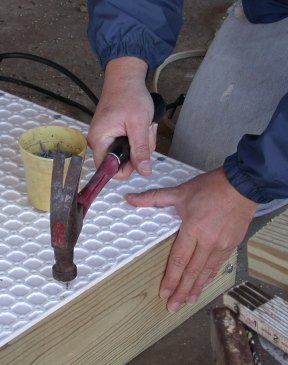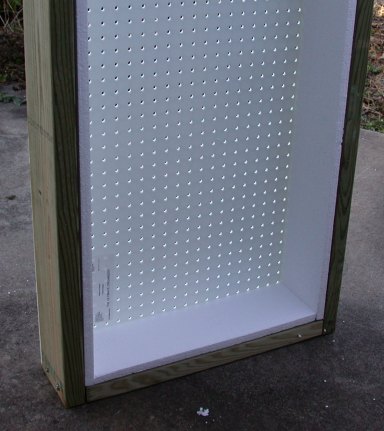Build a long-lasting bottom-heat propagating box...
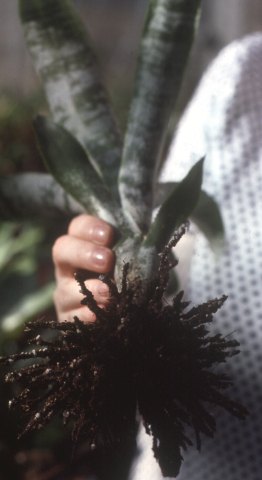 | There’s nothing like bottom heat for starting seedlings or propagating cuttings. If you don’t believe me, look at the roots on this Aechmea fasciata pup! |
Tools you will need
Saw (if you cut the lumber yourself - use a mask if and when cutting pressure treated lumber.)
Electric drill and bits
7/16 socket fitted to drill (to fit bolt heads; optional but easier than a ratchet)
Ratchet or open end wrench to finish tightening the bolts
Knife to cut Styrofoam
Calking gun
Hammer
| Parts required | |
| 1 | 2x6, 12′ - pressure treated (if you want it to last) |
| 1 | 2′ x 4′ plastic peg board with holes (available at Lowes) |
| 8 | hex head lag bolts – 4″ long |
| 14 sq. ft. | Styrofoam - ¼″ to ¾″ thick |
| 1 tube | panel adhesive |
| 1 | soil heating cable with thermostat (I used Charley’s Greenhouse model 8052 – 26′) |
| 1 | piece of hardware cloth or other metal mesh - 2′ x 4′ |
| 30 | short galvanized roofing nails (about ¾″) |
| lot | large twist-em's |
| 15 pounds | sand |
Step 1 Build the box frame
Cut the 2x6 into four pieces, two four feet long and two 21″ long. Set up the box on a level surface, with the two 21″ pieces inside the ends of the two four foot pieces. This will insure a flat finished box. Drill two holes (approx ¼″ diameter) ¾″ from the end of each four foot piece 1½″ from the top and bottom. This will roughly center the holes. Drill about ½″ into the end of the smaller pieces. When done, fit drill with a smaller pilot sized bit (a little smaller in diameter than the screw) and drill 2½″ holes into the ends where the original holes were started.
Fit your drill with a hex socket if available and screw in each of the bolts. Since your box may not be perfectly square, don’t go quite in all the way. Put the box flat on the floor and fit the “Peg Master” plastic pegboard on top. Square up with the box. Drill small pilot holes in every fourth pegboard hole on the outside edge. Hammer in the roofing nails. Finish the bolts with a socket if necessary.
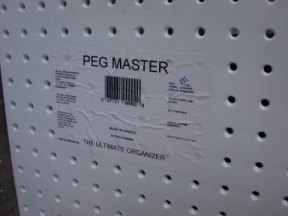
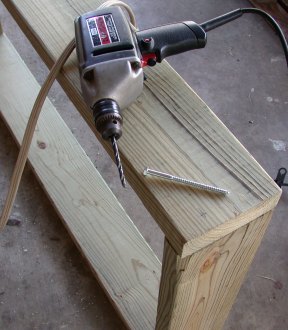
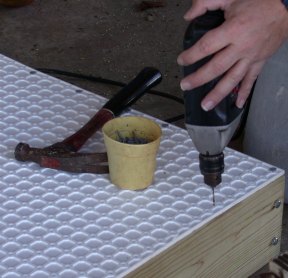
Step 2 Line with insulation
Cut the Styrofoam into pieces fitting the sides first. This will allow water to drain out the bottom without keeping the wood wet. Secure the Styrofoam to the wood and plastic using the paneling adhesive. This is not critical since gravity will keep the bottom in place and the soil mix will tend to keep the sides in place. Once dry, cut a series of small holes from the bottom through the holes in the plastic through the Styrofoam. This provides drainage. Go slowly so you don’t blow out the Styrofoam when you come out the other side (the top).
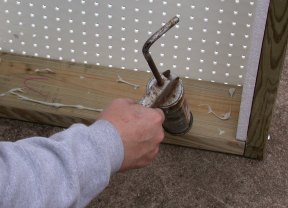
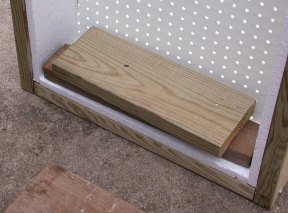
Step 3 Prepare the heating cable
Trim the metal mesh to allow about 1″ inside the Styrofoam. The exact size will depend on the thickness of the Styrofoam that you use. Lay out the heating cable in a serpentine pattern on the mesh maintaining a reasonably constant distance between wires. The cord can exit through the box side or simply come out the top any side. Just be sure that the heating part of the cable and the thermostat remain on the mesh. Using “twist-em’s”, fasten the heating cable to the mesh. Don’t install just yet. The purpose of the mesh is to maintain cable spacing and to protect the cable (especially when removing well rooted cuttings), and the box will use less energy and stay nice and warm
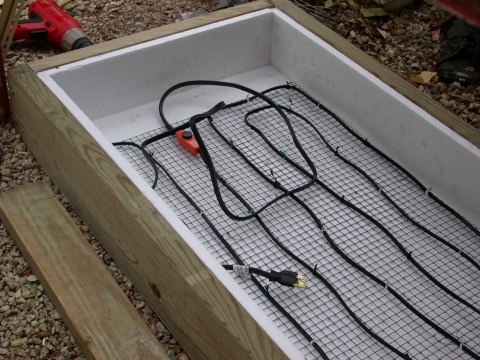
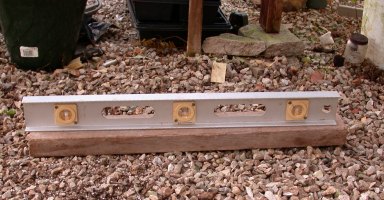
Step 4 Level the ground and put the box in place
Since things are getting heavy, now prepare the location for the box. It should be relatively level. The box can sit on the ground or be placed on a series of 2x2″ or 3x4″ planks (think bed slats). The only concern is that the plastic needs to be supported at several places in the middle since the moist mix will be fairly heavy. If the box sits right on the ground the galvanized nails will eventually rust (but not for quite a while).
Step 5 Install cable and filling
Lay in about ½″ of sand on the bottom. Press in the wire mesh with the attached heating cable on the bottom side if the thermostat will allow. Mine was too large and I put the cable on top. Just don't leave pups in too long or the roots will envelope the mesh and cable!. Fill with your favorite propagating mix. You can add a “Quonset hut” style roof of clear plastic on fiberglass rod hoops to maintain humidity.
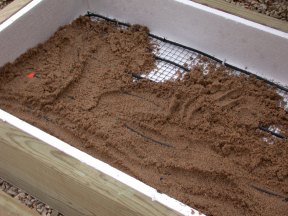
Now plug in the cable (your greenhouse should have a GFI protected circuit), take some pups or start some seed, and watch them go! (Yes, those are bananas!)

